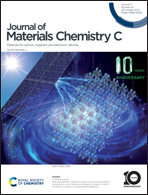Hydrophobic cross-linked nanoparticles comprising polystyrene and poly(thiophene-diketopyrrolopyrrole) segments for non-volatile memory applications†
Abstract
A series of molecular nano-floating gate memory devices with charge-trapping sites based on conjugated terpolymer-based nanoparticles are demonstrated. The conjugated terpolymers comprising polystyrene (PS) and poly(thiophene-diketopyrrolopyrrole) (PDPP) segments tend to self-assemble into conjugated polymer nanoparticles. Nanoparticles of the conjugated PDPP segments are embedded in an insulating PS matrix and act as chargeable polymer electrets for nonvolatile memory applications. When the PDPP ratio of the polymers increases, both the charge mobility and storage ability can be significantly improved. Furthermore, the influence of the polymer architecture (triblock or random copolymer) on the memory behavior is investigated. A triblock copolymer synthesized through an end-capping approach exhibits the highest charge mobility of 0.74 cm2 V−1 s−1. On the other hand, a copolymer synthesized through a random terpolymerization approach has the largest memory window of 97.8 V. To the best of our knowledge, this is the first work investigating the influence of the polymer architecture on charge transport and memory behavior. Moreover, synaptic devices based on the randomly terpolymerized PDPP-PS polymers exhibit strong paired-pulse facilitation of up to 252%. These results show that randomly terpolymerized particles have great potential for use in neuromorphic computing. This work demonstrates the effect that the polymer architecture (triblock or random terpolymer) and PDPP/PS ratio have on the performance of non-volatile memory applications.



 Please wait while we load your content...
Please wait while we load your content...